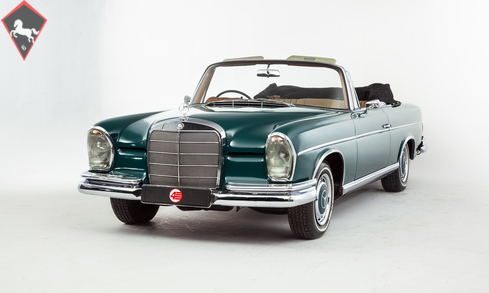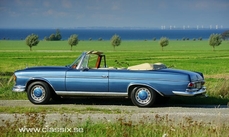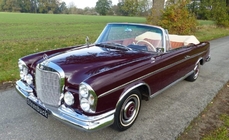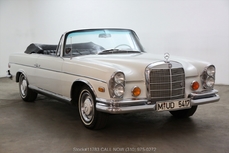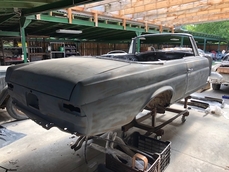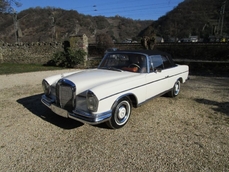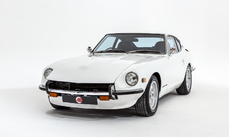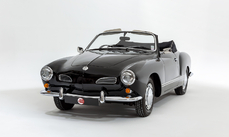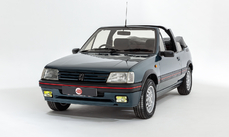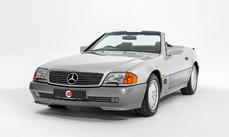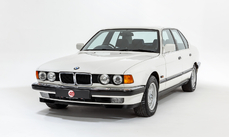Mercedes-Benz 300SE Cabriolet w112 300 SE Cabriolet RHD 1964
General description :
Model History
The W112 300 SE Cabriolet was unveiled alongside its Coupé counterpart at the 32nd Geneva Motor Show in March 1962. These two-door four-seater cars were the result of Mercedes’ consistent combination of technical brilliance, impressive performance and elegant design. As the last of the great six-cylinder, two-door Mercedes, the 300 SE of the 1960s represented the German manufacturer’s unrivaled efforts to produce the best handcrafted luxury automobile possible, using only the finest materials and workmanship.
In terms of their style, both coupé and cabriolet were based on the respective variants of the W111 220 SE. The full-length floor unit was adopted from the tailfin saloon, underscoring the stately presence of both two-door vehicles with their 2.75m wheelbase and overall length of 4.88m. However, these new models did feature trim elements in addition to those of the 2.2-litre cars, as well as being equipped with the engine and technology of the 300 SE saloon. Initially, the M189 IV straight-six cylinder light-alloy engine delivered 160hp at 5000rpm, having an increased output of 170hp at 5400rpm from 1964 onwards. Depending on the rear-axle ratio and the engine installed, coupé and cabriolet could reach top speeds of between 108mph and 121mph.
Standard equipment included a four-speed automatic transmission, power steering, pneumatic suspension, and a dual-circuit brake system with disc brakes all round. The additional chrome decoration consisted of a continuous trim strip in the longitudinal groove running from the headlamps to the tail lights, and distinctive trim strips on the front and rear wheel arches. In March 1963 a 4-speed manual transmission became available, and January 1964 brought the replacement of the injection system by a 6-plunger injection pump, which increased the engine’s output by 10hp to 170hp.
Production of the 300 SE Cabriolet and 300 SE Coupé was discontinued in December 1967. Over six years of production, only 708 Cabriolets emerged from Sindelfingen, and just 92 of these were in right-hand drive. The example featured here is, therefore, the most exclusive of that series.
Equipment
UK-supplied right-hand drive, 4-Speed automatic transmission, Folding soft-top in black, Instruments in English, Becker Grand Prix radio, Becker Reims short wave adapter, Complete Becker original instruction booklets, Whitewall tyres Power steering, Pneumatic suspension, Leather upholstery, Front central armrest, Rear armrest, Four-wheel disc brakes, Dash clock, Oil pressure gauge, Self-cancelling indicators, Lockable glove compartment, Original rubber boot mat, Spare wheel, Jack.
Exterior
This gorgeous W112 300 SE is one of just 92 cabriolets produced in right-hand drive. The car is finished in its original colour combo of Dark Green with contrasting Parchment leather upholstery. The paintwork is very presentable all round having been refreshed in the past, with few signs of age or wear to speak of. There are no unsightly scuffs or scrapes to the glossy finish, and all items of trim are present and correct. Some patination to the chrome is visible upon close inspection but generally a mirror shine is retained. All badges, headlamps and taillights look in particularly fine fettle, and the original black soft-top is present without any damage.
The Mercedes appears in excellent driver-quality condition overall, offering a tremendous base for further restorative work should the new keeper desire. Having seen little use under current ownership some re-commissioning will be required if it is to see regular use.
Interior
The interior is lavishly upholstered in Parchment leather with glamorous walnut trim adorning the dash fascia, instrument cluster, and A pillars. The front seats are some of the most comfortable you will find in a car of this vintage, and despite showing signs of age there is no damage to report; the rear seats remain in excellent unworn condition, as do the door panels and armrests. Edged in leather the carpets are in fine order throughout.
Glancing across the dash you’ll find the steering wheel looking fresh, the supple leather trim free of any cracks, and the original Becker radio system still in place. A really nice touch is the accompanying Becker documentation, which includes warranty cards for both the Grand Prix and Reims units. At the rear of the car the rubber mat is in great original condition having never gone brittle, and the boot floor remains solid.
ENGINE & TRANSMISSION
As a 1964 300 SE this example boasts raised compression and a larger Bosch injection pump than pre ’64 cars, resulting in an increase in performance from 160hp to 170hp. Under the bonnet the original "matching number" 3-litre straight six appears in good order. The engine feels strong on test and with almost undetectable gear changes the car is an absolute pleasure to drive.
WHEELS, TYRES & BRAKES
The Mercedes sits on 14-inch wheels with body-coloured chrome hubcaps. Each of the wheel trims present well with a bright polished finish to each rim. The wheels are wrapped in a matching set of whitewall tyres, as per original factory specification. Out on the road the disc brakes remain feeling sharp, and the smooth pneumatic suspension operates exactly as intended.
History File
This exceptionally rare UK-supplied 300 SE Cabriolet was first registered in May 1964. It was purchased by the second owner two years later but did not change hands again until 2005. It has now seen just five keepers in total, with a mere 89k miles driven.
The Mercedes is accompanied by an outstanding selection of original documentation, as detailed below. Amongst this you’ll find the original RF60 “buff logbook” registration document, invoices and correspondence from 1966 detailing the purchase made by the second owner, a selection of original 300 SE sales brochures, and the complete Becker document pack to accompany the factory-fitted radio system. The original stamped service book and owner’s manual are also present, along with a copy of the factory data card to verify the specification.
Contents of the History File as follows:• RF60 registration book• Service book• Owner’s manual• 300 SE Sales brochure• 300 SE Supplementary brochure• 300 SE Supplementary paint colours brochure• 300 SE technical specification leaflets• 1964 Mercedes-Benz price list• Becker document wallet• Becker Grand Prix/Reims operating instructions• Becker Grand Prix/Reims warranty card• Becker Grand Prix service and parts manual• Copy of original Mercedes-Benz factory data card• Invoices and correspondence dating back to 1966• MOT certificates dating back to 1978• DVLA vehicle ownership history• V5C
http://www.4starclassics.com/for-sale/mercedes-w112-300-se-cabriolet-rhd-for-sale/
1964 Mercedes-Benz 300SE Cabriolet w112 300 SE Cabriolet RHD is listed sold on ClassicDigest in Kingsley by 4 Star Classics for £109995.
Car Facts
Car type : Car Make : Mercedes-Benz Model : 300SE Cabriolet w112 Model Version : 300 SE Cabriolet RHD Engine size : 3.0 Model Year : 1964 Sub type : Convertible Location : Hampshire
Sold
Seller Information
Sold
People who viewed this Mercedes-Benz 300SE Cabriolet w112 also viewed similar Mercedes-Benz listed at ClassicDigest
Other cars listed for sale by this dealer
About Mercedes-Benz
In the annals of automotive history, the journey of Mercedes-Benz is a tale that unfolds with the ingenuity of its founding pioneers. In the year 1886, Karl Benz crafted the Benz Patent Motorwagen, a creation that would go down in history as the world's inaugural automobile. Unbeknownst to him, this moment marked the genesis of what would evolve into the most illustrious premium car manufacturer globally. The financial underpinning of this pioneering venture, interestingly, was provided by Karl Benz's wife, Bertha Benz, demonstrating a remarkable partnership that would set the tone for Mercedes-Benz's legacy.A parallel narrative emerged not far away, as Daimler-Motoren-Gesellschaft, founded by Gottlieb Daimler and Wilhelm Maybach, entered the scene. In 1901, they unveiled their automobile under the now-famous moniker "Mercedes," meaning "godsend" in Spanish. This name was bestowed upon the car at the behest of Emil Jellinek's daughter, the distributor for Daimler-Motoren-Gesellschaft. The wheels of innovation were set in motion.
Fast forward to 1926, a pivotal year that witnessed the merger of Daimler with Benz & Cie., culminating in the birth of Daimler-Benz. The amalgamation saw the adoption of "Mercedes-Benz" as the distinguished trademark for their automobiles, fusing the legacies of two visionary entities into one.
Contrary to perceptions of conservatism, the trajectory of Daimler-Benz unfolds as a chronicle of industry firsts. From the introduction of the honeycomb radiator to the float carburetor, and the pioneering implementation of four-wheel brakes in 1924, Daimler-Benz consistently pushed the boundaries of automotive innovation. The diesel-powered Mercedes-Benz 260 D in 1936 marked the inception of diesel engines in passenger cars. The iconic Mercedes-Benz 300SL Gullwing made history as the first car with direct fuel injection, albeit the Gutbrod's tiny 2-stroke engine can claim precedence.
Safety innovations became a hallmark, with Béla Barényi's patented safety cell design in the "Ponton"-models in 1951, featuring front and rear crumple zones. The W116 450SEL 6.9 saw the introduction of the Anti-Lock Brake system (ABS), another pioneering safety feature. From the first production airbags and beyond, the legacy of "firsts" continued to be etched into the fabric of Daimler-Benz.
Over its centennial journey, Mercedes-Benz has not merely produced cars but has sculpted automotive icons. The SSKL, 710 SSK Trossi Roadster, 770K Grosser, 540K Spezial Roadster, 300SL Gullwing, w100 600 Pullman, w111 280SE 3.5 Flachkühler, w113 230SL Pagoda, w109 300 SEL 6.3, and w201 2.3-16 Cosworth stand testament to the brand's commitment to engineering excellence.
The roaring Silver Arrows, or "Silberpfeile," including the W 25, W 125, W154, W165, and W196, created a legacy of dominance on the racetrack. These machines were not merely cars; they were expressions of precision, speed, and an indomitable spirit that left their competitors in the dust.
As Mercedes-Benz marches into the future, it does so not just as an automaker but as a custodian of a legacy, a torchbearer of innovation, and a beacon of automotive excellence. The road ahead is sure to witness the continued fusion of cutting-edge technology, timeless design, and an unwavering commitment to setting new standards in the world of automobiles.
One luminary figure who left an indelible mark was Béla Barényi, often heralded as the "father of passive safety" for his pioneering work in safety engineering. His patented safety cell design, featuring front and rear crumple zones, became a hallmark of Mercedes-Benz's commitment to occupant safety, setting new standards that reverberated throughout the automotive world.
Moving through the chronicles, the collaborative genius of Wilhelm Maybach, alongside Gottlieb Daimler, laid the foundation for Daimler-Motoren-Gesellschaft. Their innovations not only birthed the first Mercedes but established a culture of relentless pursuit of technological excellence that remains integral to Mercedes-Benz's DNA.
In the post-merger era of 1926, Ferdinand Porsche emerged as a prominent figure within Mercedes-Benz. His work on the Mercedes-Benz S-Type, a supercharged race car, garnered acclaim and set the stage for a legacy that extended far beyond the marque. Porsche's impact would later extend to his eponymous company, but his influence at Mercedes-Benz during those formative years was pivotal.
As the 20th century progressed, the legendary Rudolf Uhlenhaut emerged as a key figure. Uhlenhaut, an accomplished engineer and the driving force behind the iconic Silver Arrows, played a crucial role in Mercedes-Benz's dominance in motorsports. His engineering prowess and attention to detail were instrumental in creating some of the most formidable racing cars of the era.
In the latter half of the century, figures like Bruno Sacco, the head of design at Mercedes-Benz from 1975 to 1999, left an indelible imprint on the brand's aesthetic identity. Sacco's design philosophy, characterized by clean lines and timeless elegance, shaped iconic models like the W126 S-Class and the W201 190E, solidifying Mercedes-Benz's reputation for luxury and sophistication.
The narrative would be incomplete without acknowledging the contributions of engineers like Hans Scherenberg, whose leadership in the 1970s ushered in a new era of technological innovation at Mercedes-Benz. Scherenberg's tenure saw the development of groundbreaking technologies, including the Anti-Lock Brake system (ABS) and the introduction of airbags in production cars.
